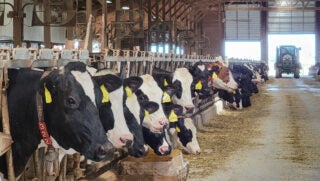On a recent trip to Garrett Brothers Farm — a more than 600-acre produce farm just outside of Gainesville, Florida — I was able to tour it to learn all about eggplant harvest!
It’s not uncommon to find eggplants being deep fried, baked, or finding a spot in a delicious Italian parmigiana dish. I learned that Italian cuisine is likely where a majority of Garrett Brothers’ eggplants end up — the grocery stores of the New York and New Jersey areas, where the Italian population is more prominent. New Jersey is actually called the “Garden State” for a reason and is known as the eggplant capital of the world — it’s where 66 percent of the world’s eggplants come from! Florida ranks No. 2 in U.S. in eggplant farming, where the crop plays a strong role in Italian cuisine.
As for myself … well, I’m still learning to master the art of cooking them.
Consuming the wild ancestors of modern eggplant varieties date back over 2,000 years to India, and it spread from there. China domesticated crop cultivation around 500 B.C., and it had reached Africa and parts of Europe by the 14th century A.D. “These early cultivars were so bitter in taste that Europeans used them only as beautiful ornamental garden plants,” according to New Jersey’s cooperative extension. “When sweeter varieties were developed in the 18th century, the eggplant reached the gourmet dinner plates of Italy, Greece, Turkey, and France. … Less than 75 years ago, eggplant in America was still thought of as ornamental with its violet star-shaped flowers, colorful caps, and glossy skin.”
Eggplant in the Florida region are a 90-day crop, meaning they’re ready to harvest 90 days after planting. Eggplants plants can reach up to 4.9 feet in height, and although they are perennial plants, they are most commonly grown as annuals. At the Garrett Brothers Farm, eggplant start off growing in a greenhouse and are then transplanted in late August with their first pick right around mid-October. These photos were taken mid-November:

View this post on Instagram
In this photo, the professional harvesting crew is on their fifth pick, which is really good! They pick about once a week on average and look for the best and most ripe fruits (yes they are a fruit, technically a berry!) and, at the time, most likely had one more harvest to go. This field will then be rotated into a different crop.
The professional harvesting crew — from the H-2A temporary agricultural worker program — picks three to four days a week on average. The H-2A program is helpful for both workers and farmers alike. Farmers are guaranteed a harvest crew and workers are guaranteed benefits, job security, and competitive salary. (The program can be explained in depth here.) Oftentimes, these valuable workers receive free housing, transportation, child care, etc., and where would we be without these amazingly skilled workers?
Below is a short video I took that explains how the harvest process works:
One acre and one cutting yields around 8,500 of these fruits, which means that this acre can be productive enough for nearly 35,000 eggplants! That’s a lot of food! The crew all have different roles, from cutting and hauling in buckets to removing sticks and sorting the eggplants to where the best looking fruits are classified as “fancy.”
Eight boxes of eggplant equal a bushel, and each box contains 18 to 20 of them; farmers are paid based on market price supply and demand. Sometimes it’s profitable, and sometime it isn’t, it all depends. After harvest is completed, the crew work together to pull sticks, plastic, stakes, and drip tape out of the field.
Eggplant can be prepared to be eaten in a wide variety of ways, including steaming, stewing, sautéing, frying, grilling, pickling, or baking. The only limitation is that eggplant cannot be eaten raw. And the experts will tell you: Whether to peel the skin or not is a personal preference — there’s no “right” way.
Does learning where your food comes from make you crave it? For me, the more I know about a crop the more I want to cook with it. So, here is a healthy recipe for that eggplant Parmesan I’m still trying to perfect. 😉
Michelle Miller, the Farm Babe, is a farmer, public speaker and writer who has worked for years with row crops, beef cattle, and sheep. She believes education is key in bridging the gap between farmers and consumers.



